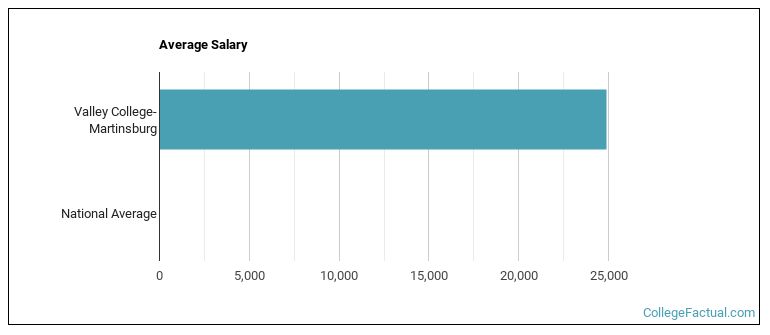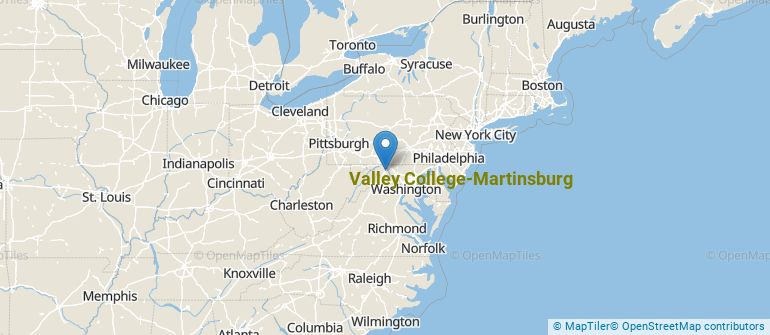 by our College Data Analytics Team
by our College Data Analytics TeamExplore the best ranked schools for the programs you are most interested in.
Valley College of Technology was not ranked in College Factual's 2025 Best Overall Colleges report. This could be for a number of reasons, including lack of data.
Returning adults and other non-traditional students may appreciate the fact that Valley College-Martinsburg has an open admissions policy. This means that you'll only have to submit basic materials, which may include proof that you completed high school or an equivalent program.
The student to faculty ratio is often used as a measure to gauge how much access students will have to their professors - the lower the number, the better. At Valley College-Martinsburg, this rate is 24 to 1, which is high when compared to the national average of 15 to 1.
Another measure that is often used to estimate how much access students will have to their professors is how many faculty members are full-time. The idea here is that part-time faculty tend to spend less time on campus, so they may not be as available to students as full-timers.
The full-time faculty percentage at Valley College-Martinsburg is 100%. This is higher than the national average of 47%.
Valley College-Martinsburg has a freshmen retention rate of 100%. That's a good sign that full-time students like the school and their professors enough to want to stick around for another year. It's also a sign that the admissions team did a good job in choosing applicants who were a good fit for the school.
During the 2017-2018 academic year, there were 628 full-time undergraduates at Valley College of Technology.
| $0-30 K | $30K-48K | $48-75 | $75-110K | $110K + |
|---|---|---|---|---|
| $24,356 | $23,009 | $24,576 | $27,866 | $31,161 |
The net price is calculated by adding tuition, room, board and other costs and subtracting financial aid.Note that the net price is typically less than the published for a school. For more information on the sticker price of Valley College of Technology, see our tuition and fees and room and board pages.
It's not uncommon for college students to take out loans to pay for school. In fact, almost 66% of students nationwide depend at least partially on loans. At Valley College of Technology, approximately 86% of students took out student loans averaging $9,242 a year. That adds up to $36,968 over four years for those students.
Get more details about paying for Valley College-Martinsburg.

See which majors at Valley College-Martinsburg make the most money.
Get more details about the location of Valley College-Martinsburg.

Contact details for Valley College of Technology are given below.
| Contact Details | |
|---|---|
| Address: | 287 Aikens Ctr Edwin Miller Blvd, Martinsburg, WV 25404-6203 |
| Phone: | 304-263-0979 |
| Website: | www.valley.edu/ |
| Most Popular Majors | Bachelor’s Degrees | Average Salary of Graduates |
|---|---|---|
| Health & Medical Administrative Services | 240 | NA |
| Allied Health & Medical Assisting Services | 61 | NA |
| Entrepreneurial Studies | 21 | NA |
| Information Technology | 20 | NA |
| Business Administration & Management | 19 | NA |
| Computer Systems Networking | 5 | NA |
| Computer Information Systems | 2 | NA |
| Nursing | 0 | NA |
Online learning is becoming popular at even the oldest colleges and universities in the United States. Not only are online classes great for returning adults with busy schedules, they are also frequented by a growing number of traditional students.
In 2022-2023, 615 students took at least one online class at Valley College-Martinsburg. This is a decrease from the 621 students who took online classes the previous year.
| Year | Took at Least One Online Class | Took All Classes Online |
|---|---|---|
| 2022-2023 | 615 | 461 |
| 2021-2022 | 621 | 510 |
| 2020-2021 | 628 | 504 |
| 2018-2019 | 365 | 365 |
Learn more about online learning at Valley College-Martinsburg.
Footnotes
*The racial-ethnic minorities count is calculated by taking the total number of students and subtracting white students, international students, and students whose race/ethnicity was unknown. This number is then divided by the total number of students at the school to obtain the racial-ethnic minorities percentage.
References
More about our data sources and methodologies.